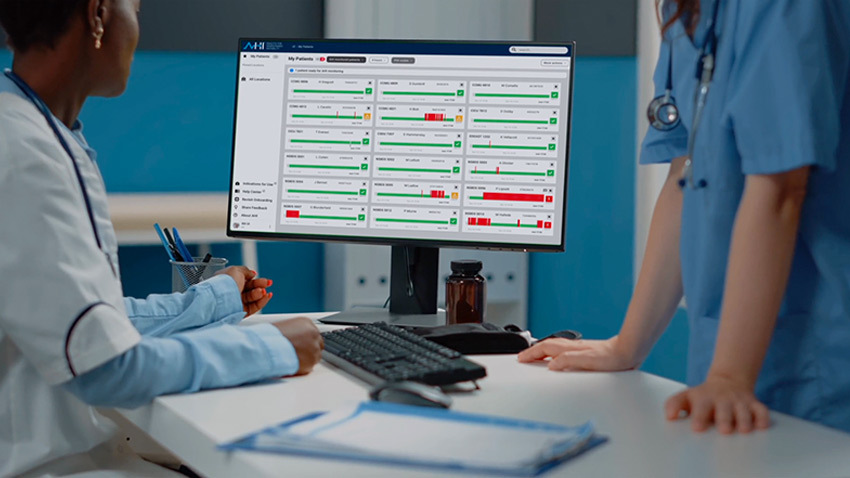
Credit: Fifth Eye, Inc. via University of Michigan
The technology developed at the University of Michigan continuously uses data from a single electrocardiogram lead
An artificial intelligence-driven device that works to detect and predict hemodynamic instability may provide a more accurate picture of patient deterioration than traditional vital sign measurements, a Michigan Medicine study suggests.
Researchers captured data from over 5,000 adult patients at University of Michigan Health with the Analytic for Hemodynamic Instability. Developed at the U-M Weil Institute for Critical Care Research and Innovation, AHI is a software as a medical device designed to detect and predict changes in hemodynamic status in real-time using data from a single electrocardiogram lead. The researchers compared the results against gold standard vital sign measurements of continuous heart rate and blood pressure measured by invasive arterial monitoring in several intensive care units to determine if the AHI could indicate hemodynamic instability in real-time.
They found that the AHI detected standard indications of hemodynamic instability, a combination of elevated heart rate and low blood pressure, with nearly 97% sensitivity and 79% specificity. The results are published in Critical Care Explorations (a Society of Critical Care Medicine journal).
The findings suggest that the AHI may be aThe implication of such a technology is that it has the potential to save lives not only in the hospital, but also at home, in the ambulance and on the battlefieldble to provide continuous dynamic monitoring cThe implication of such a technology is that it has the potential to save lives not only in the hospital, but also at home, in the ambulance and on the battlefieldapabilities in patients who traditionally have intermittent stThe implication of such a technology is that it has the potential to save lives not only in the hospital, but also at home, in the ambulance and on the battlefieldatic vital sign measurements, says senior author Ben Bassin, M.D., director of the Joyce and Don Massey Family Foundation Emergency Critical Care Center, also known as EC3, and an associate professor of emergency medicine at U-M Medical School.
“AHI performs extremely well, and it functions in a way that we think may have transformative clinical utility,” Bassin said. “Most vital signs measurements are static, subject to human error, and require validation and interpretation. AHI is the opposite of that. It’s dynamic, produces a binary output of ‘stable’ or ‘unstable,’ and it may enable early martialing of resources to patients who may not have been on a clinician’s radar.”
Traditional vital signs have limitations, including limited accuracy in non-invasive monitoring and the fact that patients who are not at obvious risk for immediate deterioration may only be monitored periodically every 4-6 hours or longer. The AHI, which was approved by the United States Food and Drug Administration in 2021 and is licensed to Fifth Eye, Inc. (a U-M spinoff), was designed to address those limitations.
“The vision of AHI was born out of our continued inability to identify unstable patients and to predict when patients would become unstable, especially in settings where they cannot be intensively monitored, said co-author Kevin Ward, M.D., executive director of the Weil Institute and professor of emergency medicine and biomedical engineering at Michigan Medicine.
“AHI is ideally suited to be utilized with wearable monitors such as ECG patches, that could make any hospital bed, waiting room or other setting into a sophisticated monitoring environment. The implication of such a technology is that it has the potential to save lives not only in the hospital, but also at home, in the ambulance and on the battlefield.”
Researchers say future studies are needed to determine if AHI provides clinical and resource allocation benefits in patients undergoing infrequent blood pressure monitoring. The next phase of research will focus on how AHI is used at Michigan Medicine.
Original Article: Patient deterioration predictor could surpass limits of traditional vital signs
More from: University of Michigan
The Latest Updates from Bing News & Google News
Go deeper with Bing News on:
Patient deterioration monitoring
- More efficient ways to monitor patient vital signs developed in NHS hospitals
Investigators have published the findings of a four-year study looking at how often hospital patients should have their vital signs monitored by staff.
- Switching Between Beta Blockers in Heart Failure Patients: Rationale and Practical Considerations
If a consideration to switch is being driven by clinical deterioration ... monitoring of blood pressure and heart rate in the outpatient clinic. Switching initially was done between patients ...
- Surgeon found guilty of multiple violations still practicing in Colonial Heights
A Colonial Heights surgeon botched surgeries, harmed patients and lied to the Medical Board. Despite repeated violations, he never lost his license.
- GE HealthCare Receives FDA Clearance for Portrait VSM, Building on Its Growing Ecosystem of Connected Patient Monitoring Solutions
GE HealthCare Receives FDA Clearance for Portrait VSM, Building on Its Growing Ecosystem of Connected Patient Monitoring Solutions ...
- CLEW Expands Its Intelligent Clinical Surveillance Platform to All Inpatient Settings
CLEW, a clinical intelligence and predictive surveillance company, today announced the general availability of its FDA-cleared, AI-driven, intelligent clinical surveillance platform. Built upon ...
Go deeper with Google Headlines on:
Patient deterioration monitoring
[google_news title=”” keyword=”patient deterioration monitoring” num_posts=”5″ blurb_length=”0″ show_thumb=”left”]
Go deeper with Bing News on:
Analytic for Hemodynamic Instability
- VRSK Verisk Analytics, Inc.
Verisk Analytics, Inc. provides data analytics and technology solutions to the insurance markets in the United States and internationally. It offers policy language, prospective loss costs ...
- Forex Analysis: What it is & Best Analysis for Trading
If so, forex analysis is your key to success. By evaluating market trends and predicting future movements, forex analysis empowers traders like you to maximize profits and minimize risk.
- Impella Pump Improves Survival in STEMI-Related Cardiogenic Shock
In the event of hemodynamic instability, treatment could be escalated to additional mechanical circulatory support after randomization in either group. In the pump group, treatment could be ...
- Microaxial Flow Pump or Standard Care in Infarct-Related Cardiogenic Shock
In the event of hemodynamic instability, treatment could be escalated ... Details of the statistical methods are provided in the statistical analysis plan, available with the protocol.
- Analytics & Data
Get your daily dose of search know-how. Subscribe To Our Newsletter. Daily search marketing tidbits for savvy pros. In a world ruled by algorithms, SEJ brings timely, relevant information for SEOs ...
Go deeper with Google Headlines on:
Analytic for Hemodynamic Instability
[google_news title=”” keyword=”Analytic for Hemodynamic Instability” num_posts=”5″ blurb_length=”0″ show_thumb=”left”]









